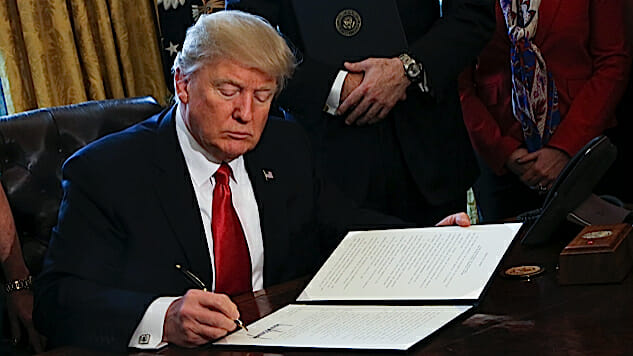Trump’s Travel Ban is Testing the U.S. System of Government
Photo courtesy of Getty
Are we headed towards a constitutional crisis over Donald Trump’s xenophobic travel ban? It sure looks like it.
A constitutional crisis in this case is, among other things, the systemic failure of institutions in the government. A battle between two or three—in this case two— of the branches of the US government that ends with a clear winner in theory but another winner in practice could provoke that failure. And the prerequisites are in place.
In the two weeks since Jan. 27, when the President signed an Executive Order barring entry to the country for people from seven Muslim-majority nations, the government is pulling apart at the seams as the executive and judicial branches fight over who has the final word on the order.
The administration has lost every major court battle thus far. On Thursday, the order had its greatest defeat thus far as the Ninth Circuit Court of Appeals unanimously rejected the ban in favor of the arguments against it from the states of Washington and Minnesota.
In the ruling, which you can read here, the court explicitly rejected the Trump administration’s argument that the courts had no right to intervene in issues of national security.
The Government has taken the position that the President’s decisions about immigration policy, particularly when motivated by national security concerns, are unreviewable, even if those actions potentially contravene constitutional rights and protections…..
There is no precedent to support this claimed unreviewability, which runs contrary to the fundamental structure of our constitutional democracy.
Trump responded with his characteristic poise and grace.
SEE YOU IN COURT, THE SECURITY OF OUR NATION IS AT STAKE!
— Donald J. Trump (@realDonaldTrump) February 9, 2017
This isn’t the first critique Trump has lodged against the judiciary, one of the three co-equal branches of government. On Feb. 5, the President called Seattle Judge James Robart a “so-called judge” in an enraged tweet after Robart struck down the ban. And Trump gave a stern warning to the Ninth Circuit ahead of its ruling on Wednesday during remarks at the Major Cities Chiefs Association and Major County Sheriffs’ Association conference.
-

-

-

-

-

-

-

-

-

-

-

-

-

-

-

-

-

-

-

-

-

-

-

-

-

-

-

-

-

-

-

-

-

-

-

-

-

-

-

-








































